WOMAD – Brooklands New Plymouth, 17-19 March 2023: Concert Review Part Two
WOMAD 2023 and the final day of the world music, art and dance celebration continues the love fest, and ends in the realm of the Gods.
The sun is up, the sky is blue/ it’s beautiful and so are you/ Dear Prudence, won’t you come out to play…
Dark storm clouds threaten through the morning , but they lift as if on cue as the opening act Pandit Ronu Majumbar and Dr Jayanthi Kumaresh take their place on stage.
Dr Kumaresh is from India and is an expert on playing the saraswati veena, related to the classical sitar. Her doctorate comes from the study of this instrument.
Majumbar is a world-famous flute-player from Varanasi, the ancient city of India. He has played with the likes of Ravi Shankar, Phillip Glass and virtuoso banjo-slinger Bela Fleck, who performed here yesterday.
They are joined by a tabla player whose name I didn’t catch, but he is of the same calibre as the other two.
They play a blend of the classical musical styles from Hindu and Carnatic culture. What that means is complex music of lyrical intensity and myriad emotions. Flows like the glacial alpine rivers that feed the Ganges River and shivers through you. Balances the naked sun starting to toast everyone.
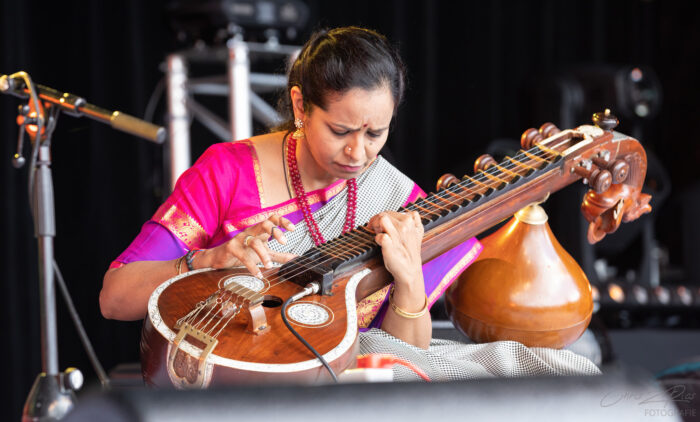
The flute sounds Indian but with definite Celtic and Gypsy tones. Proof that world music has forever been blending and stealing from each other. The speed at which he can play I have rarely experienced.
The veena has superb slide and vibrato tones. The strings sound like a heavier gauge than a sitar. Think of a dobro player hit by the holy ghost. Kumaresh plays with a light touch. Even on the long passages it is more like mental caresses.
The table player is no passenger. When they give the drummer some, he infuses some macho energy.
The raga they perform seems to be something the Byrds nicked around 1967, the Moog Raga. It’s an outtake on the Notorious Byrd Brothers CD.
ACAPOLLiNATiONS
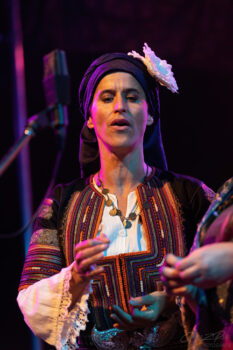 This is an acapella trio put together by Tui Mamaki. Born in France to a Kiwi father and French mother, she grew up in New Zealand and sounds it in voice.
This is an acapella trio put together by Tui Mamaki. Born in France to a Kiwi father and French mother, she grew up in New Zealand and sounds it in voice.
She was captivated by the other-worldly sounds of the Mystere de Voix Bulgare. The special haunting sounds of the Bulgarian women’s choir, of with there is no comparison to. Bewitched, as you might say, she went there in 2011 and stayed much longer than she expected.
It has ancient folk music connections, but the music is also born of Soviet era influence along with other recent-times European input, West and East.
So, she became a witch herself and created this trio, with Chelsea Prastiti and Sally Howe. Both New Zealanders, with Greek and Cook Island roots.
They recreate the mysterious sound, despite not having forty female voices singing in multiple harmonies.
A song about Ruffia on her death bed. A lament at first, the voice in a lower register like Sara Carter from the Original Carter Family of 1927. Relaxation always precedes the approach of death. The harmony voices slowly elevate the mood as they ascend to the Bardo.
The song of Marie Houbava is an older folk tune, but with the distinctive harmonies.
There is Sicilian donkey song which lets forth the hee-haws. A tradition in many countries including America, we could certainly do with more donkey/ass/mule tunes these days. But not horse. That’s different, and there are still plenty of those.
The song of the enchanting flute-player. Angelic, celestial voices with the signature choke and sobs. Maybe you get an idea with some of the best of George Jones’ sad songs. Not White Lightning which is more hiccups.
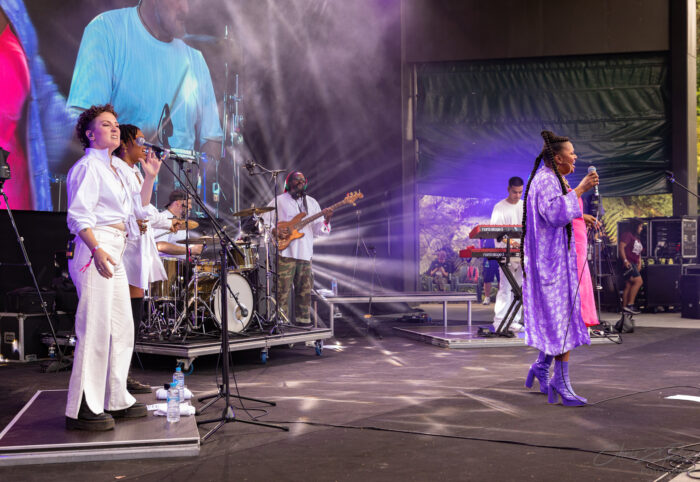
Deva Mahal
Deva Mahal is the best classic female soul singer in New Zealand currently, and she lays it out on the big Bowl stage. I have heard her in smaller venues, and she can lift the roof literally. She translates this well to a big outdoors arena, where vocal presence can get a little daunting.
She’s the daughter of the great rhythm’n’blues singer Taj Mahal. Her younger sister Zoe Moon is there on backing vocals. Along with an ace band.
Think of the great ones like Aretha, Mavis and Gladys and you get the picture of the sound she projects. Rooted in Gospel, Southern Soul and torch singing R’n’B. The peak years from the Fifties to the Seventies.
Current EP Future Classics Vol One is featured. She sings Run Me Through from that, and it has that classic American Top Forty Seventies Soul sound. The light funk of the bass guitar propels this.
Run Deep, from the self-titled album has a Philly Soul sound.
I Want You for All Time. It is the slow burners where her mastery is to the fore.
Fantastic Negrito
Fantastic Negrito was born Xavier Amin Dphrepaulezz, into a predominantly Muslim family in Massachusetts. He has had a particularly fraught upbringing which has involved racial tension, crime, near-death experiences and the merry-go-rounds of an artistic genius.
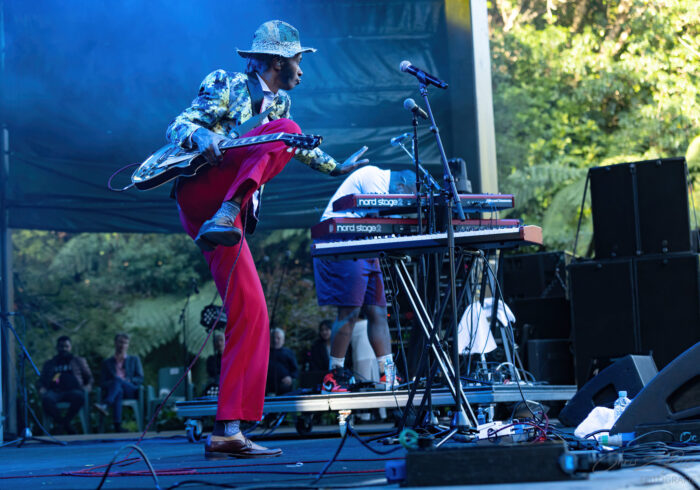
He’s a Grammy award winner. A lot of his musical expression is rooted in the social climate of America 1968 to 1972. Assassinations, burning cities and extreme racial violence, Nixon and J. Edgar Hoover.
It was also a time of great music and maybe the full fruition of what people consider wonderful about the Sixties. White Album, Hendrix, Jefferson Airplane, Sly and the Family Stone, Kent State University and Altamont, Sex Machine to Exile on Main Street. That was a ride!
Negrito’s album from last year White Jesus Black Problems is presented close to its entirety. It could equally be seen as Black Jesus White Problems. This is an inspired expansion of the idea that Sylvester Stewart sang in ’68 with Don’t Call Me Nigger, Whitey (Don’t Call Me Whitey, Nigger).
The album is a reflection on his ancestors in the late 1800s and what was, and still is, the black experience in America. A love story and the human experience amidst slavery, racism, hate and sexual tension.
The music is Blues and Americana. The roar of the Country Blues from the Mississippi Delta. The spicy gumbo of Louisiana and New Orleans.
Voodoo is there with black cat bones and a little John the Conqueroo. He is a Black cat and resembles a Super Spade like Hendrix (or Prince, same thing). He is the current manifestation of Sly Stone.
The electric nerve sound of the single-string diddey-bow.
American Indian chanting Blues of Charley Patton, who was more white than black and is the great creator of the American music.
That distorted dirty guitar jook joint sound has also been heard from Justin Adams at this festival.
The train rhythm they get into and expand is only a hairs breadth from Bo Diddley. He is now one of those Elders of music tradition.
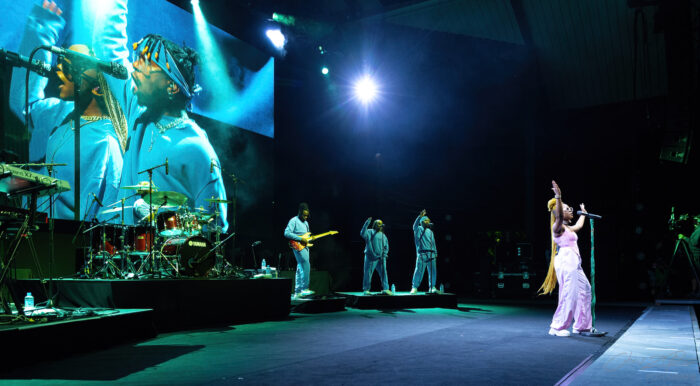
Sampa the Great
Sampa Tembo was born in Zambia and raised a bit in Botswana. With her all-Zambian band she is Sampa the Great, and she is a fast-rising international artist.
She is proud of her heritage, and proud to have helmed the band to the Glastonbury festival in recent times.
A Southern African soul singer, and there is a good deal of the Soweto pop sound there.
Paul Simon with his Gracelands album features this. Since that could be close to ground-zero for World music and therefore WOMAD, let’s give him a shout-out.
Rap is here but in a softer, soul to pop style. Neo-Soul if you prefer.
They work a more seductive groove for their set. It is not the hard grab of edgy and aggressive rap. They’re not itching to smash your face. They want to stroke you and dance with you.
WOMAD is still the long dance party that it has been for a while.
Black Girl Magic was written for little sister, and it has a nice soul groove echoing Curtis Mayfield in the Seventies.She is certainly eclectic. La Guida is a Spanish language workout intertwined with Afro-Pop.
Cimafunk
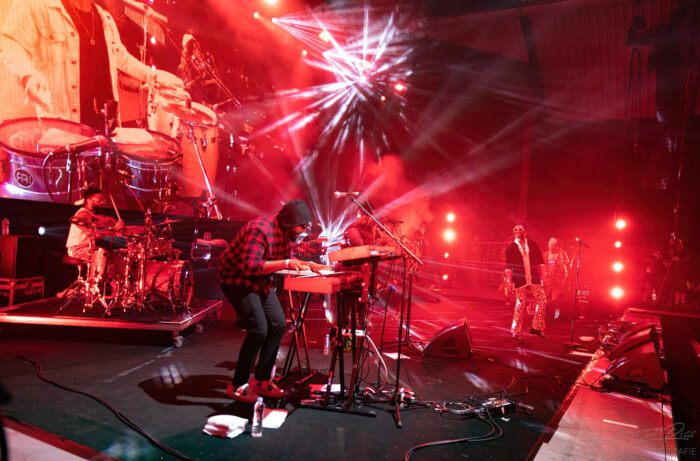
Cimafunk are from Cuba, and they look amazing. Two spectacular young women play sax and trombone, and they steal the show every time they feature. Let’s say they can shake that booty!
It’s a big tribe on stage and they waste no time in laying out their Cuban dance funk. A faster rhythm than Sampa the Great. A lot of percussion. The conga player stands out. Drums are the essential beating heart of a band, and this has multiple ones.
A very cool dude fronts as lead singer. A flat-top haircut. Glitter shades and snatches of James Brown dance moves. They set a fast pace in rhythm, but they also manage a loose and languid backbone.
They do some Carnivale. Then go for harder rap which evolves into the sound of Kool and the Gang’s Jungle Boogie. Get down, get down! The dance groove never lets up from start to finish.
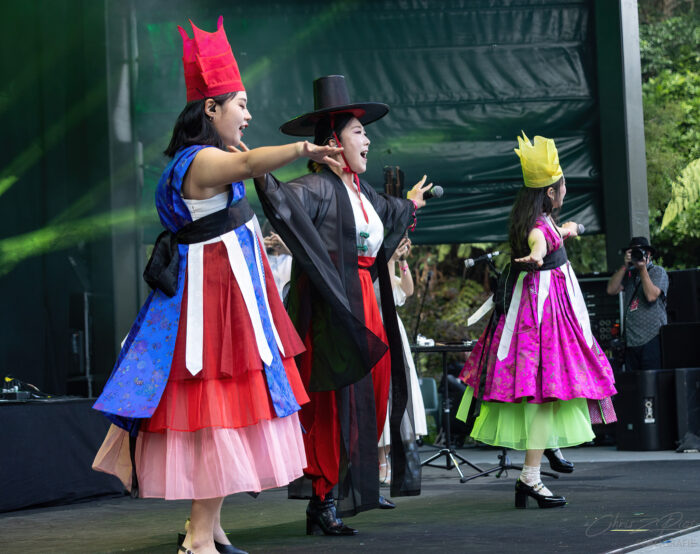
The festival ends with the Rizwan Muazzam Qawwals.
They start and finish the show. The ecstatic dance of the God realm. The nephews of Nusrat Fateh Ali Khan continue the great tradition. The nine men who make up the collective One surpass their legendary uncle/father/inspiration when they assemble on stage and perform for us as the closing act.
Multiple voices, handclaps like God’s syncopated thunder. The eternal universal spirit.
Dum Dum Ali. Mustt Mustt. You might recognise them. The large late evening crowd are transported. Some can whirl the dervish physically. Everyone can in their mind. There is no separation.
The crowd demand and get an encore. No mean feat as each song easily breaches fifteen minutes.
Well, it does have to end sometime. But not really. This performance and this WOMAD 2023 will stay with all who were here. And then go out into the world.
Rev Orange Peel